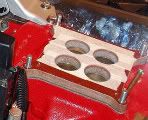This picture shows a 1/2 thick phenolic spacer being fitted to an ECZ 9425-B four barrel manifold. The phenolic material is way less likely to transfer heat than aluminum and is a little better at preventing distortion of the carb base than a stack of gaskets. Avoid the poly "plastic" spacers as their heat resistance is usually poor on an exhaust heated street manifold - and like the guys have said, use a closed center that keeps the 180° manifold divided. These are predominently torque engines and open center spacers usually lend themselves more to a higher rpm range.
The spacer is available from both Speedway Motors and Moroso as an exact match to the original Ford manifold bores. After laying down some tape, transfer the throttle bore diameters of the bigger 600cfm carb (a proper size matching gasket works good) to the phenolic base. A small half-round file or other similar tool will make short work of enlarging the upper bores and tapering them down to the manifold size. Making the upper end slightly larger than the carb throttle bore insures there will be no impedence to airflow exiting the carb. The plan is to leave no abrupt edges that extend into the flow path at both upper and lower edges of the spacer - so take care not to enlarge the bottom holes. I usually finish the phenolic material with 400 grit paper to make things nice and slick.
At lower right you can see a small hole in the Moroso spacer - there is a second hole on the diagonal opposite. These are provided to allow "pinning" the spacer in an exact location on the manifold. There is enough clearance in the stud holes to slightly misalign the spacer over the manifold bores during assembly (and leaving a step). Moroso recommends drilling the manifold for two rollpins that always return the spacer to an exact match (I didn't). This is certainly good practice - but I put a slight radius on the top edge of the iron manifold and wrapped some tape on the studs (to improve the fit) instead.
Don't talk yourself out of doing something to properly match the carb, spacer and manifold! The primary throttle blades of the carbs rotate clockwise as seen from the driver's side. Because the shaft centerline is by necessity above the mounting base - the blades may actually rotate open over the smaller bores with nothing more than a gasket adding to the space between. As the blade swings open from idle - it will actually begin to close the rear of the venturi passage by mating with the spacer or manifold bore radius below. This is a major disruption for part throttle operation as all of the airflow must abruptly transfer to the the front wall of the venturi and cross the upside edge of the throttle blade.